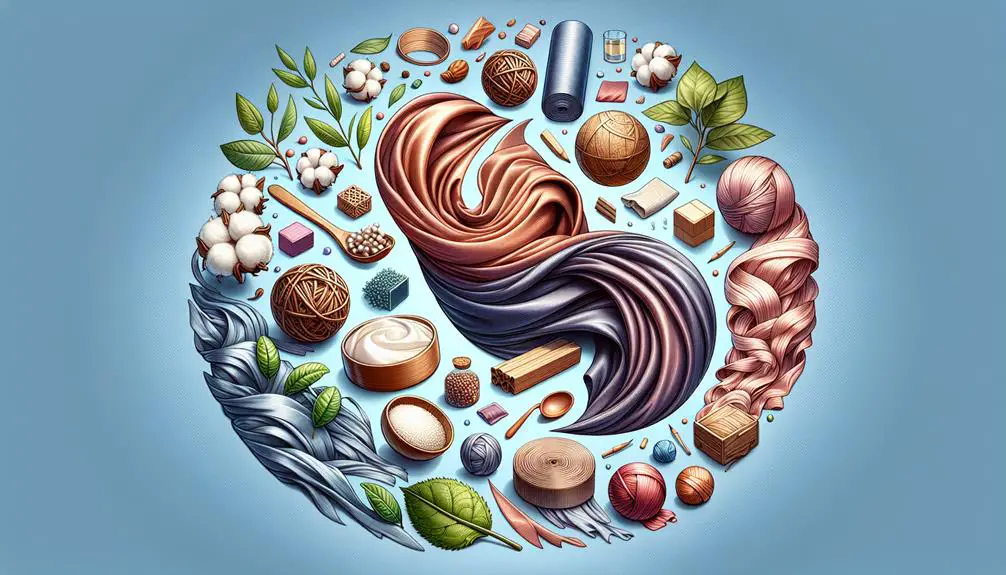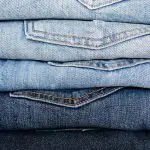Yes, rayon is definitely a fiber! It started out in the late 1800s as a cheaper alternative to silk, made from cellulose from wood pulp. It's super soft, smooth, and really comfortable for clothes and textiles. Rayon is also strong, durable, and good at absorbing moisture, which keeps your skin cool. Plus, it's used in tons of stuff like stylish clothing, curtains, and even medical supplies. There are different production methods like viscose and modal, each having their unique perks. If you're curious, there's plenty more to explore about how rayon fits into our everyday lives and its environmental impact.
Table of Contents
Key Takeaways
- Rayon is indeed a fiber, derived from cellulose found in wood pulp.
- It is transformed into fiber through various production methods such as the viscose and lyocell processes.
- Designed as an affordable alternative to silk, rayon mimics silk's luxurious and soft texture.
- Rayon fibers are utilized in a range of products including clothing, upholstery, and medical supplies.
- Due to its cellulose origin and fiber structure, rayon is categorized under the group of manufactured fibers.
Origins of Rayon
Rayon first came about in the late 1800s when French chemist Hilaire Bernigaud sought an affordable alternative to silk. Back then, silk was all the rage, but not everyone could afford it. Bernigaud had a brainwave: why not create something that feels like silk but doesn't break the bank? That's where cellulose comes into the picture.
Cellulose, found in wood pulp, became the foundation of this new venture. Bernigaud figured out that this plant-based material could be transformed into a luxurious fiber. By regenerating cellulose, he essentially recycled something natural into a semi-synthetic fiber that mimicked silk's properties.
This innovation wasn't just about fashion. It was about accessibility and practicality. Rayon, being derived from abundant wood pulp, was easier on the wallet and available to more people. Plus, it offered the softness and versatility that made silk so loved.
Production Methods
Several methods exist for producing rayon, each with its own unique approach and benefits. Let's dive into the main ones: viscose, modal, lyocell, and acetate.
Viscose is the go-to method for most rayon we see and feel. It's praised for its silk-like softness and breathability, making it a favorite for comfy clothes and luxurious fabrics. Then there's modal, coming from beech trees. It's not just soft; it resists shrinking too. That's a big win for anyone who's ever pulled a favorite shirt out of the dryer only to find it's sized for a toddler.
Lyocell is the eco-warrior of the group. Made through a closed-loop process, it turns wood pulp into fiber without harming the planet. It's sustainable and feels great too. Acetate, often used in drapery and party wear, gives a smooth, luxurious feel that's hard to beat.
Here's a quick breakdown:
| Type | Key Benefit |
|---|---|
| Viscose | Silk-like softness |
| Modal | Resists shrinking |
| Lyocell | Environmentally friendly |
| Acetate | Smooth and luxurious feel |
Each type has its perks, suiting different needs and sustainability goals. Whether you're into fashion or eco-friendly materials, there's a rayon for that.
Physical Characteristics
Now, let's talk about the physical characteristics of rayon.
It's soft and smooth, which makes it great for comfy clothes and home textiles.
We'll also look at how strong and durable it is, and how well it absorbs moisture.
Texture and Softness
I've noticed that the texture of rayon is incredibly soft and smooth, much like silk. This luxurious fiber has a few standout features that make it a favorite for comfy and stylish clothes:
- Silky Texture: Rayon feels just like silk against the skin, which makes it super comfy.
- Moisture Absorption: It keeps you cool by pulling moisture away from your body.
- Lightweight: Rayon garments are light, perfect for feeling breezy on hot days.
- Breathable: It lets your skin breathe, which is always a plus in warm weather.
- Softness: The softness of rayon is just unmatched, making it ideal for everyday wear.
Strength and Durability
Rayon's robust nature makes it a top choice for durable clothing and textiles. It's strong, really. When we talk about its tensile strength, rayon outdoes natural fibers like cotton. This means it can last longer and handle more stress.
Whether it's your favorite shirt or a sturdy industrial fabric, rayon holds up well. It's built to withstand regular wear and tear without losing its shape or integrity. That's pretty impressive, right?
With the right care, rayon items keep their strength and look good over time. So, it's not just about looking great; it's about lasting quality too. Choosing rayon means opting for durability, making it a smart choice for everyday use and beyond.
Moisture Absorption Properties
Keeping you cool and dry, rayon's excellent moisture absorption makes it a top pick for warm-weather wear. It's got a bunch of perks that make it awesome for those hot days:
- Moisture Absorption Properties: It pulls in moisture, keeping you less sweaty.
- Summer Garments: Ideal for your summer wardrobe.
- Moisture-Wicking Ability: Moves sweat away to keep you fresh.
- Breathable: Doesn't make you feel like you're wrapped in plastic.
- Comfort: Stays light and comfy, even when it's super humid.
Common Uses
Rayon finds its way into a variety of everyday items, from stylish clothing to essential medical supplies. Let's dive into how widely it's used and why it's so popular. I've got to say, rayon fabric is quite versatile. You'll find it in blouses, dresses, and skirts—really adds a touch of class! Plus, it feels super comfy.
Now, beyond fashion, rayon pops up around our homes too. It's in curtains, upholstery, and bed linens. Imagine curling up in bed, surrounded by soft, smooth sheets. That's the cozy touch of rayon for you!
Then there's the medical field. Rayon's in surgical gowns and bandages. It's all about safety and comfort for both doctors and patients. In industries, this fiber's strength is key. It's used in tire cords, conveyor belts, and even insulation.
And let's not forget the hygiene products. From wipes and diapers to feminine hygiene products, rayon's absorbency is a major plus.
Care Instructions
So, let's talk about how to take care of rayon.
First up, we've gotta get the washing right—too hot and you're asking for trouble.
Then we'll look at the best ways to dry and iron it to keep your clothes looking great.
Washing Rayon Properly
To properly wash rayon, start by using cold water on a gentle cycle to prevent it from shrinking. Since rayon's production involves the viscose process, which transforms raw materials into fibers, it's super sensitive.
Here's how I keep my rayon outfits in top shape:
- Use Mild Detergent: Harsh chemicals can ruin the delicate fibers.
- Avoid Wringing: Twisting can distort its natural shape.
- Gentle Cycle Always: Protects against too much agitation.
- Sort Colors: Prevents color bleed that can ruin your lights.
- Check Labels: Some pieces might need hand washing.
Mastering these steps ensures my rayon garments stay fresh and fabulous. Keeping it simple and gentle is the key!
Drying Techniques
After washing, drying rayon correctly is crucial to maintain its shape and quality. Since rayon is a delicate cellulose fiber produced using the viscose method, you've got to handle it with care.
Never hang your rayon garments to dry; it can stretch them out or make them saggy. Instead, lay them flat on a towel. This helps absorb extra moisture and speeds up the drying process.
Also, keep them out of direct sunlight. Sun can fade the colors and weaken the fiber. While the fabric is still damp, gently reshape it. This keeps the silhouette just right and ensures the garment stays looking its best.
Ironing Tips
Ironing rayon requires a gentle touch to keep it looking its best. Here's how I make sure my rayon outfits stay smooth and chic without any damage:
- Low Heat: Always set your iron on low heat. Rayon can't handle too much heat without getting damaged.
- Pressing Cloth: Use a pressing cloth over your rayon or iron on the reverse side to protect it.
- No Steam: Avoid using steam to prevent water spots that can ruin the look.
- Small Sections: Iron small sections at a time, and don't let the iron sit too long in one spot.
- Immediate Care: Once you're done, hang or fold the item right away to keep those pesky wrinkles away.
Environmental Impact
Rayon production's heavy use of harmful chemicals and deforestation practices significantly harms our environment. The process involves not just chopping down vast areas of rainforest, but also using some pretty nasty chemicals that mess with our planet's health.
Each year, thousands of hectares of critical rainforest are lost, all in the name of producing rayon. This deforestation isn't just about losing trees; it impacts wildlife, disrupts ecosystems, and contributes to climate change. It's a big deal because these forests are crucial for absorbing CO2 from our atmosphere.
On top of the tree issue, the chemicals used in making rayon, especially during the viscose process, are no joke. These harmful chemicals don't always stay put in factories. They find their way into our environment through viscose production effluents. This means they end up in local waterways, which harms aquatic life and eventually affects us, too.
It's also worth noting that only a tiny fraction of the wood used comes from places that take care to replenish what they take. Most don't bother with sustainable practices, which only adds to the environmental toll.
Health and Safety Issues
Beyond the environmental toll, the production of rayon also raises serious health and safety concerns for workers. Let's dive into what makes working in these factories risky:
- Exposure to carbon disulfide: This chemical isn't just unpleasant; it's downright dangerous. Workers exposed to it can face severe neurological issues, and it doesn't stop there—reproductive problems can also arise.
- Respiratory troubles from toxic fumes: Breathing in the fumes from chemicals used in rayon production can lead to major respiratory problems. It's not just about coughing; it can affect your whole respiratory system long-term.
- Skin irritation from chemicals: Handling chemicals like sulfuric acid without proper protection can burn or irritate your skin. It's as uncomfortable as it sounds and can keep you from your work or daily activities.
- Environmental pollution: Plants producing rayon contribute to local environmental pollution. This doesn't just affect the planet; it impacts community health around the factory too.
- Contaminated water sources: Improper disposal of chemicals can lead to water contamination. This isn't just an environmental issue—it's a direct health hazard for anyone relying on these water sources.
It's clear that while rayon might be useful, it carries significant risks that can't be ignored.
Alternatives to Rayon
Given the risks associated with traditional rayon, exploring sustainable alternatives is crucial. Let's dive into some of these options!
First up, there's the Lyocell process. It's a cleaner choice because it uses a closed-loop method. This means most chemicals and water get reused. Pretty smart, right? Tencel, a popular type of Lyocell, is made from wood pulp. It's not only eco-friendly but also soft and strong. If you're looking for a fabric that feels good and you can feel good about, Tencel's the way to go.
Then there's Cupro. This fabric comes from cotton linter, the fluffy stuff around the seeds of the cotton plant. It's biodegradable and has a silky texture. So, it's great for both your closet and the planet.
Another cool alternative is EcoVero. It stands out because it focuses on environmentally responsible production methods. Choosing EcoVero means you're opting for a fabric that's less taxing on our environment.
Lastly, we've got bamboo rayon. It's made from bamboo, which is a super fast-growing plant. This makes bamboo rayon a renewable choice that's also quite gentle on our planet.
Frequently Asked Questions
Is Rayon a Fiber or Fabric?
I've been asked if rayon is a fiber or fabric. It's actually a fiber, derived from cellulose, used to make various fabrics. So, it's not a fabric itself but a crucial component.
Is Rayon a Healthy Fabric?
I'd say rayon's generally healthy to wear. It's breathable, comfy, and often hypoallergenic. Just make sure you're buying high-quality rayon and caring for it properly to avoid any chemical residue issues.
Is Rayon a Natural Fiber Like Cotton?
No, rayon isn't a natural fiber like cotton. It's semi-synthetic, made by chemically altering plant material. While it feels natural, it's actually man-made, which is crucial to know for fabric choices.
Does Rayon Biodegrade?
Yes, rayon does biodegrade. It's made from cellulose, which bacteria can break down naturally. This makes it more eco-friendly compared to synthetic fibers, which take much longer to decompose.
- Can Rayon Be Steamed? - April 18, 2024
- Is Rayon a Fiber? - April 18, 2024
- Is Rayon Good for Your Skin? - April 18, 2024







